ARTISTS’ STATEMENT
In this work architecture, sound, performance, water and site work together to create a poetic interpretation of a soldier’s experience of conflict.
‘No man’s land’ refers to the impasse, the place no one dares traverse, the gap of fear and uncertainty between two sides of tentative safety. A memory, a metaphor inherited from the impossible stand-off of World War One trench warfare.
How can this empty floating space, this vacuum of devastation be poetically reimagined?
THE ARTWORK
A Sensory Experience
No Mans Land refers to the impasse, the place no one dares traverse, the gap of fear and uncertainty between two sides of tentative safety –a memory, a metaphor inherited from the impossible stand off of World War 1 trench warfare.
How can this empty space, this vacuum of devastation be poetically reimagined?
Floating Walkways
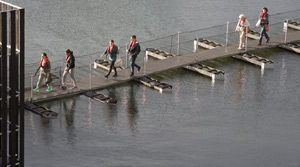 Nomanslanding is a contemplative floating artwork experience.
Nomanslanding is a contemplative floating artwork experience.
5 artists – Artists Robyn Backen, Andre Dekker, Graham Eatough Nigel Helyer and Jennifer Turpin were invited by three curators from Australia, Germany and Scotland to work together to create a site specific touring artwork, a world wide commemoration of WWI.
The collaborative work has premiered in Darling Harbour, Sydney, and will travel to the Clyde River in Scotland and Ruhrort, Duisberg in Germany. Each location has a connection either with World War I industry production or places where soldiers embarked on ships leaving for the front. The unity between these locations lay in their connection to bodies of water. Water became the universal symbolic thread common to each site. It became the physical and metaphoric driver for conceptualising and designing the artwork. In the artwork water is symbolic of the space between life and death.
‘Nomansland’ is that place between two army forces in World War I that no one wanted to traverse – an impasse, the gap of fear and uncertainty between the two opposing sides. Nomanslanding is a creative poetic reimagining of this empty space. In the artwork ‘Nomansland’ becomes a space of memory and metaphor. It becomes a place for the audience to contemplate states of vulnerability that happen during conflict, and a lament on the sadness of loss and devastation of war.
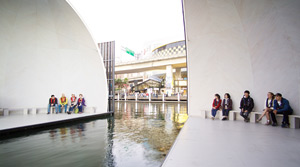 The artwork comprises a floating dome that is split into two separated half domes that slowly draw together. The artwork acts as a bridge, connecting two separate and opposing sides to create a new joint territory, bringing people together to experience, remember and contemplate. The opening and closing movement becomes a breathing space on the surface of the water.
The artwork comprises a floating dome that is split into two separated half domes that slowly draw together. The artwork acts as a bridge, connecting two separate and opposing sides to create a new joint territory, bringing people together to experience, remember and contemplate. The opening and closing movement becomes a breathing space on the surface of the water.
A circle inside a square. A dome inside a box. The pure simple geometric forms of the floating structure resonate with traditional commemorative and spiritual architecture; dome as chapel, slatted walls as temple.
The quiet, smooth dome is the inner sanctum, the charred timber slatted walls, like columns of the outer temple. The charring is symbolic of both death and destruction and in traditional Japanese architecture it is a method to preserve and increase longevity of timber.
 The architecture is loosely modeled on the Temple of Janus in ancient Rome. Janus (who had two faces on either side of his head) was the God of gateways/ thresholds. His temple had entrances at either end. In times of war the gates were open. In times of peace they were closed.
The architecture is loosely modeled on the Temple of Janus in ancient Rome. Janus (who had two faces on either side of his head) was the God of gateways/ thresholds. His temple had entrances at either end. In times of war the gates were open. In times of peace they were closed.
The artwork mimics this with its two entrances and gateways which open and close during the performance.
The Nomanslanding dome is conceived as a space where different voices, languages and sounds can reverberate, ricochet and be whispered. In the manner of much traditional sacred architecture the perfect dome is a piece of acoustic architecture, creating acoustic ‘sweet spots’ and resonances. Like a ‘whispering gallery’ the sound of a voice is amplified in eerie reverberation.
A six part performance takes place every 25 minutes presenting the audience with an abstract ;
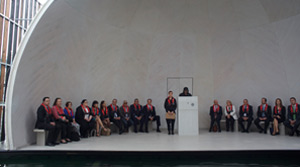 It begins with the audience being processed and prepared for the crossing in army tents on floating barges, moving to a processional experience of going out over the floating walkways. Participants are ushered into the dome by a dark figure who controls the movement of the dome /boat. He is like the mythological character ‘Charon” , the boatman who ferried the dead across the River Styx.
It begins with the audience being processed and prepared for the crossing in army tents on floating barges, moving to a processional experience of going out over the floating walkways. Participants are ushered into the dome by a dark figure who controls the movement of the dome /boat. He is like the mythological character ‘Charon” , the boatman who ferried the dead across the River Styx.
Within the open dome an abstract soundscape conjures the ‘going off to war’. As the dome closes the audience is engulfed by sounds of conflict and battle. The darkness of the closed dome and changing soundscape evokes the thoughts, feeling memories and realities of being inside the head of a soldier on the edge of death.
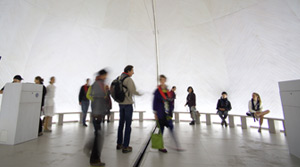 A solo performer begins to sing a lament, an elegy, a reflection and contemplation – conjuring sadness and loss. As the doors open and light floods in the lament culminated in a moment symbolizing hope and redemption.
A solo performer begins to sing a lament, an elegy, a reflection and contemplation – conjuring sadness and loss. As the doors open and light floods in the lament culminated in a moment symbolizing hope and redemption.
The artwork was commissioned by:
Sydney Harbour Foreshore Authority, Urbane Kunste Ruhr, Germany and Glasgow Life Scotland
THE LAMENT:
We will meet you at the river
We’ll draw closer on the tide
You can hear us in the water
From the shore to the other side
All our lives brought here together
To flow before your eyes
At last on Nomanslanding
Cast off the line untied
Spare us your tears
Spare us your tears
Erspare uns die Tränen German
Epargnez-nous vos larmes French
A whisper in the darkness
A drifting on the stream
Through us you cross the river
The wake of all we’ve been
Our breath floats on the water
A murmur joins your own
A prayer within the darkness
A crossing faithfully done
Spare us your tears
Spare us your tears
Risparmia le lacrime Italian
Nedavej vase slzy Czech
Spare us your tears
Spare us your tears
Bespaar ons de tranen Flemish
Bicim icin aglama Turkish
Words by Andre Dekker and Graham Etough
Music by Cora Schmeiser and Ben Fink
Soundscape Voice Credits:
- German FEMALE: Bettina Kaiser
- German FEMALE: Lisa Schoetell
- French FEMALE: Sophie Leprêtre
- Russian FEMALE: Gulnara Shayakhmetova
- Turkish FEMALE: Zeynep Berk
- Scottish Female: Catherine Elliot
- English Female: Sarah Ward
- Australian FEMALE: Julie Ewington Joyce Watson, Artist
- German MALE:Franz-Josef Kaiser, Artist
- English MALE: Artist
- Australian/New Zealand: Mike Floyd, Ian Hobbs, Artist
With special thanks to Helen Salmon, Chris Murphy, Jamie Dawson, Phil Riddett, Elgin Wolf, Christina Danick, Daniel Klemm and a huge assorted team of marketing, operational and delivery support from Australian, German and Scottish partners.
THE SITES AND PROJECT PARTNERS
Each partner organisation is concerned with similar thematic questions in relation to their sites—urban connection to waterways, urban development and maritime echoes of WWI. Each partner produces temporary, public art projects in urban settings that are accessible and provocative. The partners also share an interest in new models that present opportunities for personal and organisational growth and sector development.
On a deeper level, this partnership represents a centennial regrouping of historical friends and foes: country members that were both enemies and allies during WWI. One hundred years on, this meeting of histories will be the site of a powerful arts collaboration.
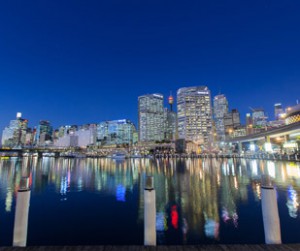 Darling Harbour
Darling Harbour
Sydney, Australia
Partner: Sydney Harbour Foreshore Authority / NSW Centenary of ANZAC
Located in the centre of Sydney, Darling Harbour was once an industrial port area and the site of troop embarkation for the Great War in 1915. It was completely rebuilt and re-established as a cultural and entertainment precinct for Australia’s Bicentenary in 1988, and is now visited by more than 25 million people annually. Despite this, Darling Harbour is continuing to improve its urban connectivity and between 2014 to 2016 it is undergoing significant urban redevelopment.
Nomanslanding had its World Première in Sydney in April 2015 as a part of Australia’s Centenary of ANZAC commemoration events.
Sydney Harbour Foreshore Authority owns and manages some of New South Wales’ most significant assets, including Sydney’s heritage and cultural precincts at The Rocks and Darling Harbour. Between them, the precincts attract around 40 million visitors annually. In working to achieve its vision to make extraordinary places the world talks about, the Foreshore Authority produces an annual program of major arts and innovative heritage interpretation events in its public spaces. The Foreshore Authority has a long history of delivering water-based artwork and spectacle and frequently stages public art activations attended by more than 100,000 people.
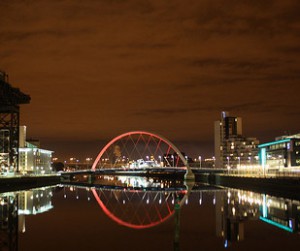 Tramway
Tramway
Glasgow, Scotland
Partner: Glasgow Life / Merchant City Festival
Tramway is an internationally renowned centre for contemporary arts and performance. Originally built as a tram shed, and scheduled for demolition, the venue was saved and reopened as a unique theatre space ahead of Glasgow’s stint as European City of Culture in 1990. Tramway remains a symbol of the city’s reinvention as a post-industrial cultural powerhouse. Its iconic and vast theatre and gallery spaces have played host to some of the most exciting theatre companies and artists from around the world, and in 2015 hosted the first Turner Prize to come to Scotland.
Glasgow Life will present Nomanslanding at Tramway in summer 2017, where it will be reimagined for its epic theatre space.
Glasgow Life (the trading name of Culture and Sport Glasgow) is a private company and a charitable trust which manages Glasgow City Council’s cultural and sporting infrastructure and resources on its behalf through a service agreement. The company manages the city’s leading museums and art galleries, including the Gallery of Modern Art, Kelvingrove Art Gallery and Museum, and the Zaha Hadid-designed Riverside Museum. It also manages the internationally renowned Tramway, as well as leading international festivals such as Celtic Connections and Glasgow International Festival of Visual Art, and emerging festival platforms, such as the Merchant City Festival and Glasgow Mela. Glasgow Life was also responsible for the cultural programme alongside the Commonwealth Games in 2014.
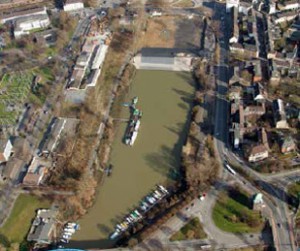 The Eisenbahnhafen
The Eisenbahnhafen
Duisburg Ruhrort, Germany
Partner: Urbane Kuenste Ruhr / Ruhrtriennale
Located at the intersection of three important waterways—the rivers Rhine, Ruhr and the Rhine-Herne-Canal—Duisburg is the harbour city for the whole Ruhrregion. Duisburg-Ruhrort was founded in the 17th century and was the starting point for the growth of the biggest river harbour in Europe during the Industrial Revolution. The former Eisenbahnhafen is a relic from industrial times which was used as a ferry port to connect the main railway-tracts on the two sides of the river Rhine. The area around the Eisnebahnhafenis the site of significant urban development.
Urbane Künste Ruhr will present Nomanslanding as part of the Ruhrtriennale in August 2015.
Kultur Ruhr GmbH currently consists of four independent programs: Ruhrtriennale, ChorWerk Ruhr, Tanzlandschaft Ruhr and Urbane Künste Ruhr (Urban Arts Ruhr). ‘Ruhrtriennale – International Festival for the Arts’ has the greatest yields among the four programs within the GmbH and is the most important public presence of Kultur Ruhr GmbH. With the new program, Urbane Künste Ruhr, which began at the end of 2011, Kultur Ruhr GmbH is returning to key experiences from the year of European Capital of Culture RUHR.2010. Urbane Künste Ruhr initiates and implements artistic projects in urban spaces, temporary architectural structures, urban interventions and artistic research projects. Kultur Ruhr GmbH has extensive experience in realising indoor and outdoor art productions on both small and large scale. Art in public space has always been part of the artistic profile of Kultur Ruhr GmH, and this has increased since the establishment of Urbane Künste Ruhr.
The partners are interested in exploring opportunities for further presentation partnerships.
Please contact us.
